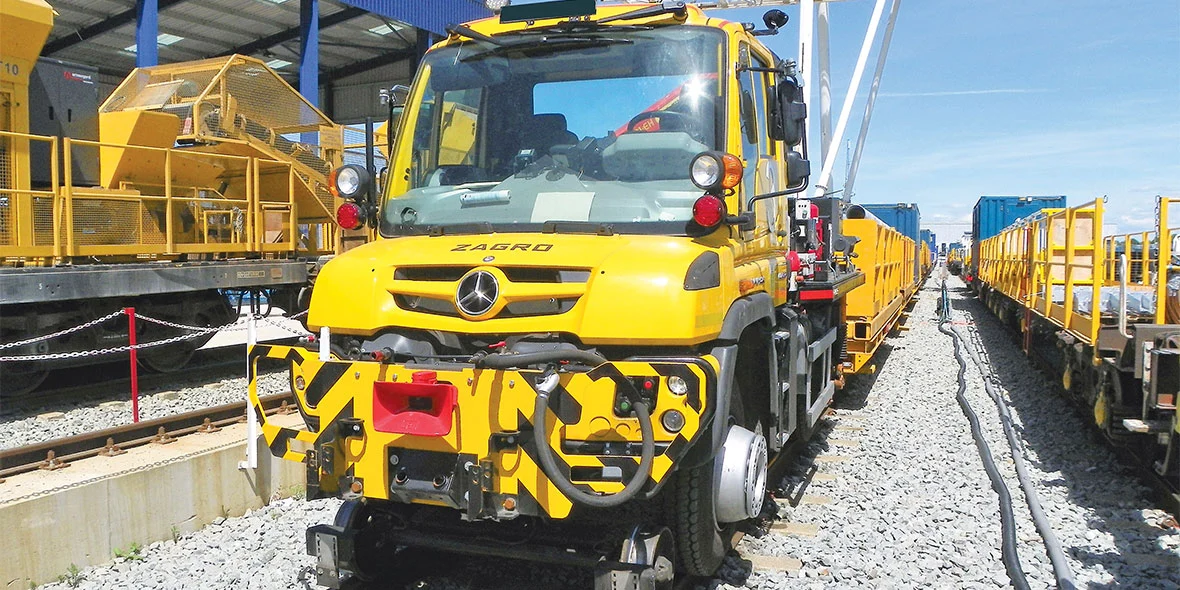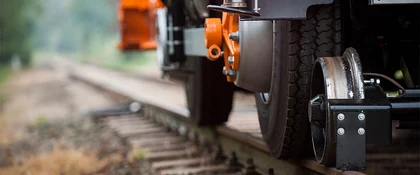Crossrail project, London: the Unimog as a crane and shunting vehicle.
It is one of Europe's largest rail projects: a new suburban rail line between Reading and Shenfield - running right across London. It runs underground, and is 21.6 km long. It runs past the existing underground network, old sewage systems and through a variety of rock layers. The work on the Crossrail route will have taken a total of ten years when the entire section opens to traffic on schedule at the end of 2019. To ensure that everything ran smoothly on this major project, the people responsible for it did not make any compromises when planning operations, and they selected the crew, partner companies and vehicle fleet precisely with these special requirements in mind. The Unimog has established itself as a reliable road-rail vehicle – and has proven itself on rail and road.
Unimog in action for tomorrow's mobility.
In order for material and machines to reach their destination reliably, the company in London responsible for construction needed efficient help on the rails. However, conventional shunting locomotives proved to be unsuitable for this job. This is because a clean, flexible and powerful vehicle solution is required for shunting work in tunnels, especially as at times, some of the construction sections can only be reached by road. This scenario is ideal for the Mercedes-Benz Unimog with road-rail equipment.
Given the special requirements, the Crossrail builders quickly decided to purchase three Unimog vehicles during the construction phase in 2016 and had them individually equipped. They wanted: a perfectly tailor-made work vehicle that meets the most advanced standards, especially in terms of exhaust technology. In cooperation with the body specialist Zagro and the Unimog dealer South Cave Tractors, a bespoke solution was developed based on the latest equipment carrier model. And the result was a brand new Unimog U 423 shunting vehicles with add-on crane superstructures.

Comfortable crane application in the tunnel.
The road-rail vehicles not only manoeuvre wagons in London, but also lay sewers and pipelines along the new railway line. Both power and performance are called for. This is because the heavy, bulky steel components must be positioned by crane, safely and with millimetre precision, in the tightest of spaces.
To do so, the Unimog is equipped with a powerful Palfinger crane in combination with a grab made by Kinshofer. A crucial advantage: the positioning of the load can be precisely controlled along three axes within the limited tunnel enclosure.
The outriggers commonly used on crane vehicles cannot be used in the Crossrail project due to the risk of damage to the track bed, so the Unimog U 423 was equipped with hydraulic supports between the vehicle body and the rear wheel hub. This system of the Unimog ExpertPartner Mulag, which is especially known for Unimog mowing and road maintenance equipment, blocks the suspension at the rear axle if necessary, thus allowing a more comfortable use of the crane even while the vehicle is moving on the rail.

Full power on the track.
The road-rail Unimog is internationally renowned for its high towing power when manoeuvring. From the towing of trams to use in industrial plants with siding. The Unimog vehicle's strength lies in the combination of direct contact between tyre and rail and a torque converter clutch to increase starting torque.
Unimog shunts Deutsche Bahn trains through the car wash
Thanks to the hydraulically adjustable rail guide, the road-rail Unimog can also switch quickly between rail and road. The London construction project has also benefited from this. For example, before the railhead was complete, wagons began to arrive at Plumstead by road. The Unimog towed them off the road trailers and on to one of several, parallel sections of short, unfinished and unconnected rail where they would remain until the rail sections were properly joined up. Once the wagon was off the lorry, of course, the shunter was trapped behind the wagon on the unfinished track, a problem for a regular rail shunter. Not for the Unimog, it just off-tracked and returned to tow another wagon on to another short piece of track, and so on.
Underneath Great Britain's capital city, the Unimog also scores highly in terms of its performance: a 475 m long concrete train would be pushed into position, inside the Crossrail tunnel, to deliver its load each night. Each morning, the Unimog was despatched to split the formation and pull it back on-rail to the Plumstead workshops for a thorough wash out before refilling again for the next night’s work. The Unimog would then off-track before joining the perimeter service road where it could travel down to the next rail access point, drop its rail guidance wheels and collect the second half of the concrete train.
The all-rounder has even surpassed the expectations of the Crossrail planning engineers. The concept as it was originally envisaged was for road-rail special vehicles carrying only up to 150 tons. But in reality, it quickly became apparent that significantly heavier loads would have to be moved. The three Unimog U 423 vehicles did not have to be asked twice. With their 231 hp each and their increased overall weight compared to the U400, the vehicles have sufficient power reserves to master even challenges like these with confidence.
Improved air quality in the tunnel.
After all, clean air is also vital when working underground. Hence, in addition to its strength and versatility, the Unimog has impressed tunnel builders above all with the low emissions from its Euro VI engine. The customer's original requirement was an engine with emission standard Euromot 4 / Tier 4 final. The Unimog with its Euro VI engine was well below the required emission levels, and compared with most modern rail-bound tracked vehicles or diesel shunting locomotives, the Mercedes-Benz road-rail vehicle emits significantly less CO2 and fine dust. And it does so with lower purchase and operating costs and less maintenance than with conventional locomotives.
In London, all Crossrail stakeholders are completely impressed by the Unimog. Even die-hard locomotive drivers quickly became enthusiastic about the advantages of the new crane, transport and shunting vehicle. More drivers will soon be trained to ensure the long-term use of the Unimog in future projects.




